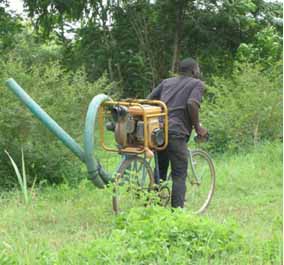For many farmers, getting the water onto their crops is a big challenge.
Farmers who have access to irrigation have substantially higher incomes and better food security than their neighbours who rely on rainfall alone. In particular, vegetable cultivation in the dry season is very profitable. But this needs a reliable method of drawing water from an available water source, whether it be a river, a reservoir, a pond, canal or groundwater.
Pumps are the obvious answer. Smallholder irrigation has existed for decades, particularly in South Asia. Ten years ago, the treadle pump was popular and the uptake was enthusiastic.
But they are hard work. There is considerable scope for expanding their use, but farmers prefer motor pumps where they are accessible either to buy or to rent, and so the treadle pump is falling out of favour.
The smallholder private irrigation sector is growing thanks largely to cheap, motorized pumps from China and India. We estimate that more than a million smallholders in SubSaharan Africa are now growing vegetables in the dry season using irrigation.
And the scope for further growth and poverty reduction is substantial.
Ethiopia – Motorized water lifting West Bengal – Treadle pumps Tanzania- Water lifting technology Ghana – Water lifting
[row][column size=”2/5″ center=”no” class=”DarkBlueBackground”]How to Support
So if a motor pump is a solution, what is the problem?
While small private irrigation is spreading spontaneously, there are still challenges. Wealthier farmers have access to information and finance while their poorer counterparts face several hurdles.
The cost can be prohibitive because the reality is that the poorest farmers do not have access to the capital in the first place. Subsistence farming cuts no slack for saving and banks don’t like lending to the poor.
Choosing the right product can be a minefield. Importers and distributors often do not understand the needs of their customers; cheap imports can be a poor choice and can be unreliable. And if the farmer’s precious motor pump should break down, she may well find that there are no spares to be found nearby and no mechanic who understands that model.
Regional Analysis – Motor Pumps SSA
Where to Invest
Similarly, a farmer needs to know what crops to grow and how to grow them to make the most of being able to irrigate land in the dry season. Our research shows this is particularly true for women farmers. Markets are often dominated by middlemen who control pricing and make it harder for farmers to realize the full potential of their crops. If left unchecked, the proliferation of motor pumps could lead to a decline in water quantity, a loss of soil fertility and pollution. Conflict can also arise from competition between public and private schemes. Smallholder irrigation is by nature individualistic which makes it more difficult to control and regulate. With appropriate support, the use of motor pumps can help reduce poverty dramatically without adversely affecting the environment.
Regional Analysis – Motor Pumps SA
Regional Analysis – Treadle Pumps SSA
Burkina Faso – Country Investment Brief
Ethiopia – Country Investment Brief
Ghana – Country Investment Brief
Tanzania – Country Investment Brief
Zambia – Country Investment Brief

Small, cheap motorized pumps have increased smallholder private irrigation, reducing dependency on rainfed agriculture.




Irrigation Service Providers: A Business Plan
An irrigation service provider owns several portable motor pumps, with which he can irrigate other farmer’s fields.
This business model offers much needed employment for individual entrepreneurs AND gives farmers affordable access to motor pumps. Read
Irrigation Service Providers: A Business Plan
[/column][/row]






